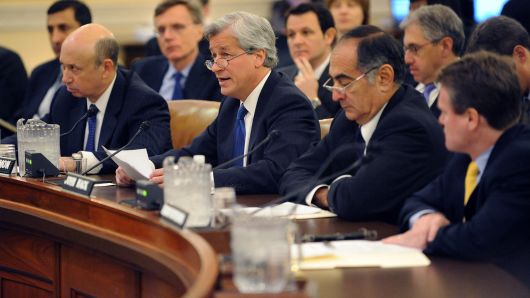
Tim Sloan | AFP | Getty Images
(L-R) Lloyd Blankfein, CEO of Goldman Sachs Group, Inc.; James Dimon, CEO of JPMorgan Chase & Company; John Mack, chairman of the Board of Morgan Stanley; and Brian Moynihan, CEO president of the Bank of America Corporation testify during the first public hearing of the Financial Crisis Inquiry Commission hearing on January 13, 2010 on Capitol Hill in Washington, DC. The Financial Crisis Inquiry Commission (FCIC) is a ten-member commission appointed with goal of investigating the causes of the financial crisis of 2007�2009.
The single biggest reason J.P. Morgan won the post-financial crisis era, according to analyst Charlie Peabody, dates back to the crisis itself. Despite Scharf’s mishap, J.P. Morgan had mostly steered clear of the excesses of his competitors. It retreated from the Wall Street business of turning shoddy subprime mortgages into bonds while competitors were ramping up. When the full force of the crisis hit, inflicting tens of billions in losses for banks including Citigroup and Merrill Lynch, Dimon had been able to preserve his balance sheet.
“That meant they were able to invest in their businesses from Day 1,” Peabody said. “J.P. Morgan generated revenue growth whereas Citi and Bank of America had to dilute the balance sheet by issuing new stock, which haunts them to this day.”
As a result, in the most important measure to investors, share return, J.P. Morgan has surged about 180 percent since the day before Lehman failed and returned more than 246 percent when including dividends. Wells Fargo has returned 115 percent, Goldman Sachs has returned 71 percent, and Morgan Stanley has posted a total return of 50 percent. Citigroup shares are still much lower than a decade ago, and Bank of America stock has returned only 1 percent.
Source: FactSet
Those, of course, are the survivors. Lehman Brothers failed in spectacular fashion, while Wachovia, Washington Mutual, Bear Stearns and Merrill Lynch were swallowed by competitors.
It’s possible that, years from now, Jamie’s post-crisis reign will be seen as the high water mark for the industry. Thanks to a web of post-crisis regulations, banks are better capitalized, less risky and better-managed. They’re likely to endure the next recession in far better shape than the last, analysts said.
“The entire industry is looking more J.P. Morgan-like in terms of the strength of their balance sheet,” Mayo said.
J.P. Morgan’s outperformance hasn’t gone unnoticed. It’s become a CEO training academy for the rest of the industry: Dimon’s deputies have gone on to lead institutions including Barclays, Standard Chartered, Visa and First Data.
 EU News Digest Latest News & Updates
EU News Digest Latest News & Updates



